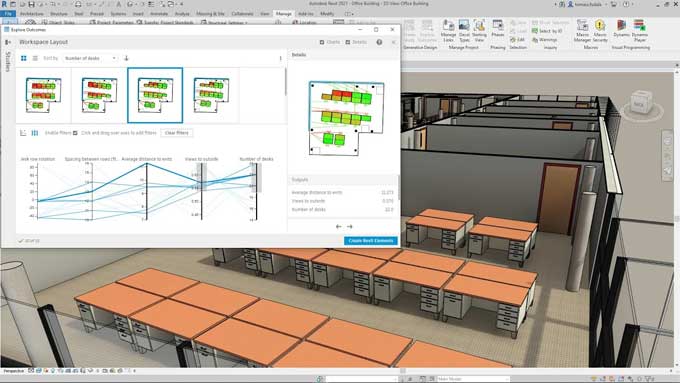The New Release of Revit Now Includes Generative Design
Tweet
Introducing Revit's new feature, Generation Design, designed to take design decisions to the next level of scale, speed, and accuracy. You'll be able to explore more options directly in Revit, supporting ideas and intuition with data, running more rigorous experiments, and satisfying clients and project teams by making better-informed decisions.
Getting more alternatives in fewer steps allows you to sort, rank, filter, and select from a list of designs according to the constraints and parameters you and your team define. Your attention would be focused on viable alternatives, filtering out all the noise.
Science and Art in Design Decisions
It is no secret that architects are experts at trade-offs and impacts. Since they're adept at finding a balance between intuition and information, they recognize that every decision has a ripple effect. As a result, both clients and design teams provide satisfying solutions to competing project goals. A design critique can be clarified more clearly using Generated Design in Revit. It enables the user to choose the best design option by evaluating, optimizing, and validating options in multiple ways.
A design study can quickly develop, tested, adjusted, and iterated with generative design in Revit. As a powerful tool, it generates many possibilities precisely because it filters out unwanted noise to focus only on those options that meet design goals. You can adjust parameters using simple slider controls when creating generative designs or compare different results clusters by comparing them. Consider all the design factors in balance or focus on one, bringing depth, breadth, and rigor to meetings with your team and clients.
Features of Generative Design in Revit
Take a look at the sample studies available in Revit 2021.
The AEC Collection 2021 includes three design studies common to commercial building programs in Generative Design.
1. Using three boxes of differing heights and relative positions, one can study your mass's visual impact along with calculating its surface area and volume.
2. Create a workspace layout in a room incorporating a door, a window, and columns. Distances to exits, views to the outside, and more can be calculated.
3. Calculate quality ratings for external views from different viewpoints in the model.
The Generative Design button on the Manage tab in the ribbon allows you to launch these studies directly from any model view. Defining the study type and goals is the first step. Your desire to study the variables, assign weights using the interface.
You can specify how Revit should assist you in ranking the design alternatives by specifying the quantity and constraining the number of alternatives you wish to create. Your study should then run asynchronously in the background so you can continue to work on your model.
Create custom studies with Dynamo
Dynamo users can take advantage of Generative Design functionality in Revit to discover what is possible by using the power of algorithms. You can connect elements of your Revit model with Dynamo's visual programming environment and create custom design studies.
Visualize & Explore Design Alternatives
You can use Generative Design in Revit to visualize the results of your study. The responsive results coordinate graph lets you sort, select, and filter the results in just a few clicks.
Browse the alternatives in 2D lists and interactive 3D thumbnails, and sort, select, and filter using the responsive results coordinate graph. Consider a scatter plot to find clusters of alternatives with similar characteristics.
The study can either focus on a preferred set of outcomes or rerun using revised criteria to see the impacts as priorities change. If you've chosen the best option, click Create Revit Elements, & then populate your model with that alternative.
You can use Generative Design in Revit to intelligently choose approaches that find a middle ground or to optimize a single factor, like maximum daylight or slimmest building profile. You can use Generative Design in Revit as a design assistant, collecting data quickly to help you make better-informed decisions.
To get online demonstration, watch the following video tutorial.
Video Source: Autodesk Building Solutions

Gallery
Feel free to contact us for BIM requirements. One of our representative will respond you within 24 Hours. Send us your projects requirement today and grow your project.
Explore More !







